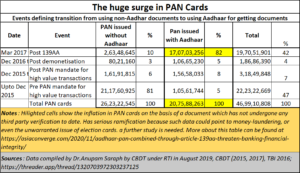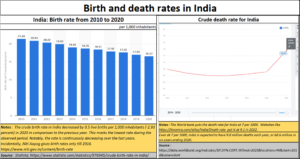Bogus Aadhaar cards imperil both Census and elections
RN Bhaskar
Shri EAS Sarma has responded to this article by writing to the Election Commission. You can find his letter at https://asiaconverge.com/2023/04/india-elections-under-threat/
 To appreciate this article better, it is important to take a close look at two Lok Sabha documents. They have a bearing on a missing Census and a flawed Aadhaar mechanism on the eve of the 2024 elections. The Lok Sabha statements are made on behalf of the government before the Parliament. They are therefore considered to be the most authentic statements of facts.
To appreciate this article better, it is important to take a close look at two Lok Sabha documents. They have a bearing on a missing Census and a flawed Aadhaar mechanism on the eve of the 2024 elections. The Lok Sabha statements are made on behalf of the government before the Parliament. They are therefore considered to be the most authentic statements of facts.
The first is the reply on 9 February 2022 to the Lok Sabha unstarred question No. 1230 on “Process of issuing Aadhaar cards”. (a copy of the Lok Sabha document can be downloaded from https://asiaconverge.com/wp-content/uploads/2023/04/2023-04-30__2022-02-09_Lok-Sabha_PROCESS-OF-ISSUING-AADHAAR-CARDS_UIDAI.pdf)
The second is the reply on 5 April 2023 to the Lok Sabha unstarred question no 5519 on “Aadhaar of deceased persons”.(a copy of this document can be downloaded from https://asiaconverge.com/wp-content/uploads/2023/04/2023-04-30__2023-04-05_Lok-Sabha_AADHAAR-OF-DECEASED-PERSONS.pdf)
Both replies were given by Rajeev Chandrashekhar, minister of state for electronics & information technology, government of India.
The tables on Aadhaar cards in the annexures to these two replies have been analysed. The data has been extracted and juxtaposed next to each other. But since the table is very large, it is not being reproduced here, but can be downloaded from https://asiaconverge.com/wp-content/uploads/2023/04/2023-04-30_two-Aadhaar-datasets.png.
Distilled tables
To make the analysis simpler, the author has extracted the key derived numbers from these two documents, and these are given in this article.
Both tables talk about a surge in the total numbers of Aadhaar cards issued.
One talks about total Aadhaar cards issued, which – for some states – is larger than the populations of the respective states. What is worrisome is that this issue of excessive numbers of Aadhaar cards was known to India’s policymakers as early as in February 2020 (https://asiaconverge.com/2020/02/aadhaar-cards-populations-many-ways-rig-numbers-financial-transactions/). Sanjay Dhotre, minister of state for Electronics and IT, informed the Rajya Sabha on 6 February 2020, (in reply to Unstarred question No.527 which enquired about Aadhaar cards), that “Seven states have Aadhaar more than the projected population as on December 31, 2019,” He further stated that the “Estimated number of deaths of Aadhaar holders has been accounted in Aadhaar saturation. These could be attributed to error in projection of population, migration of population etc.” and that “There is no plan to flag deceased Aadhaar holders [even if documents relating to the deceased person were submitted to the Aadhaar authorities].” The Rajya Sabha document which could be accessed at https://rajyasabha.nic.in/rsnew/EDAILYQUESTIONS/sessionno/251/EU7.pdf is no longer available.
Meanwhile, the “seven states” have swelled to nine.
 It is doubtful if anything has been done about this, because as the government itself admitted before the Parliament recently, that it had no mechanism to deactivate a dead person’s Aadhaar card (https://www.hindustantimes.com/business/aadhaar-deactivation-for-a-deceased-person-soon-report-101679302940813.html). It would appear, therefore, that Unique Identification Authority of India or UIDAI had created a mechanism where Aadhaar numbers could be added, but not deleted. What a shame! What short-sightedness!!
It is doubtful if anything has been done about this, because as the government itself admitted before the Parliament recently, that it had no mechanism to deactivate a dead person’s Aadhaar card (https://www.hindustantimes.com/business/aadhaar-deactivation-for-a-deceased-person-soon-report-101679302940813.html). It would appear, therefore, that Unique Identification Authority of India or UIDAI had created a mechanism where Aadhaar numbers could be added, but not deleted. What a shame! What short-sightedness!!
Other Aadhaar surges
There are other ways to inflate the number of Aadhaar cards. Another table shows that around 20 states had registered a swell in Aadhaar registrations within a 15-month period from 31 December 2021 and 28 February 2023. What is worrisome is that many of these states are alongside international land borders. The highest surges have taken place in North-Eastern States, Uttar Pradesh, and Bihar. That does call for a major investigation.
This is because birth rates in India have been around 1.66% annually. Thus, if a state registers a growth in Aadhaar cards of 2% or more, within a 15 month period, this should be a cause for investigation, if not concern. Curiously, there is no evidence of this being done.
Thus, you have a situation where Aadhaar numbers can swell because of unaccounted deaths (which could be higher than the 7 per 1,000 death rate because of the Covid deaths which the government has continued to deny). The Covid related deaths which are belied to be 4 million, ten times higher than what the government admits (do visit https://asiaconverge.com/2021/06/missing-dead-series/ and https://www.npr.org/sections/goatsandsoda/2021/07/20/1018438334/indias-pandemic-death- toll-estimated-at-about-4-million-10-times-the-official-co for more details).
Then you have unexplained surges of Aadhaar in around 20 states.
This would not have mattered much, if Aadhaar had just been another card.
But the government created rules which allowed a person to open a bank account with just an Aadhaar card. This can be confirmed from UIDAI’s circular on Use of Aadhaar for opening bank accounts (issued on 23 October 2018). In September 2020, the RBI allowed Aadhaar to be used for KYC (know your customer) purposes — https://www.paisabazaar.com/aadhar-card/rbi-allows-banks-use-aadhaar-kyc-verification/
But even earlier, in the Finance Bill of 2017, the government introduced Article 139AA in the Income Tax Act allowing holders of Aadhaar cards to be issued PAN cards as well (https://incometaxindia.gov.in/Acts/Finance%20Acts/2017/102120000000064612.htm). This rule came into effect on 1 June 2017, the same date on which GST also got effected. That in turn caused a surge in PAN card issuances (https://asiaconverge.com/2020/11/aadhaar-pan-combined-through-article-139aa-threaten-banking-financial-integrity/). As the table shows, the surge was not insubstantial.
Equally interesting is that the issue of PAN cards allows Aadhaar entitlements to go into the bank accounts of Aadhaar recipients. The amounts are routed to the bank accounts by the National Payments Corporation of India (NPCI) which (horrifyingly) is allowed to overwrite the account numbers in its database by the new account number of the Aadhaar recipient. NPCI does not keep logs of such transactions either. So, each direct beneficiary through a bogus Aadhaar card and PAN number can now receive funds, and open a new account each year, thus obliterating the total amount of money he has received fraudulently through these bogus documents.
 Link this to the bloating of numbers of slum households (https://asiaconverge.com/2021/08/slums-2-benefitting-politicians-and-graft-seekers/) which have seen the average persons per households shrivel to 0.5 per family as against 5.3 for the country (according to Census 2011). This means that slums which are known to be vote banks for politicians could be receiving 10 times the applicable subsidies thus draining the exchequer, which is paid for by the tax paying population.
Link this to the bloating of numbers of slum households (https://asiaconverge.com/2021/08/slums-2-benefitting-politicians-and-graft-seekers/) which have seen the average persons per households shrivel to 0.5 per family as against 5.3 for the country (according to Census 2011). This means that slums which are known to be vote banks for politicians could be receiving 10 times the applicable subsidies thus draining the exchequer, which is paid for by the tax paying population.
Distorting elections?
Thus, the Aadhaar gets you a PAN card, a bank account, and hence a telephone connection as well. The stage is set for getting an election card, as the requisite documents required as evidence are now available.
Right now, even while this article is being written, there are enumerators visiting each household to check if all election cards have been linked to Aadhaar cards. Thus, the huge number of Aadhaar cards have become a virtual pathway to inflating election rolls as well.
 There are only two ways by which the inflation of Aadhaar cards can be checked and neutralised. One is through the Census, which the government has not held. It was supposed to be published in 2021. The Census is the basis for the National Population Register (NPR), which in turn is the final record for citizenship and election cards.
There are only two ways by which the inflation of Aadhaar cards can be checked and neutralised. One is through the Census, which the government has not held. It was supposed to be published in 2021. The Census is the basis for the National Population Register (NPR), which in turn is the final record for citizenship and election cards.
The second way is through the office of the Comptroller Audit General (CAG) which can order an audit of all Aadhaar cards, because they have a direct impact of the Indian exchequer.
There is a third way – through the Election Commission, but that seems least likely. Remember, that it is in charge of the electronic voting machines (also known as VVPAT or Voter verifiable paper audit trail) and it has remained silent after discovering that almost one-third of the machines are defective (https://thewire.in/government/eci-denies-vvpats-defective-says-only-3-4-lakh-machines-need-preventive-maintenance). Charges about defective machines have been doing the rounds for over a decade – especially after a Congress candidate saw his fortunes reversed after the lunch hour thus getting him to become the elected candidate – but little has been done about it. This time, there is unambiguous evidence of faulty voting machines.
So, what is the way out? That is up to the courts and the legislature. But it is a shame to see the world’s largest democracy going to polls with a shadow of bogus Aadhaar cards and defective voting machines. The 2019 elections were estimated to have cost the country a whopping Rs.50,000 crore ($7 billion), according to the New Delhi-based Centre for Media Studies (https://economictimes.indiatimes.com/news/elections/lok-sabha/india/why-indias-election-is-among-the-worlds-most-expensive/articleshow/68367262.cms?from=mdr).
This time, the costs could be higher. The costs to governance, reputation and credibility will remain incalculable.






































COMMENTS